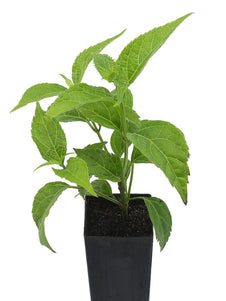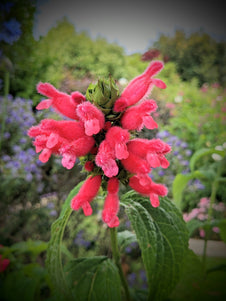









Salvia oxyphora
Salvia oxyphora

- In stock, ready to ship
- Inventory on the way

Usually available: All year
Life cycle: Perennial
Height: 1 - 2m
Position: Sun / part shade
Soil preference: Well drained
This is how we pack and send your Herb Plants to all states except TAS & WA
You will receive
- 1 Salvia Oxyphora Herb Plant in a 50 X 75mm tube - General growing instructions
All of our Herb Plants are grown organically with certified organic potting mixes and fertilizers
Botanical Name: Salvia Oxyphora
Salvia oxyphora is an herbaceous perennial with a tropical appearance, growing from 1 to 1.5 meters. The large, flowers are an attention grabbing cerise pink and appear in summer through to autumn. The inflorescence consists of terminal bracteate racemes that grow up to a 20cm long spike. The 3-4cm long corolla is red with fine hairs giving the fuzzy appearance.
The attractive, glossy green leaves are lanceolate to ovate and are quite large at 7 to 22cm long, tapering to 3-7cm wide at the tips. The pointed leaves have obvious veins and when up close it becomes clear that they are not smooth, but have fine white hairs all over the leaf. Salvia oxyphora may also be called the Bolivian Spearhead Sage due to the leaves being ‘sharp’ and ending in a point. The word ‘oxy’ means ‘bearing’ and ‘phora’ means ‘sword’ in Latin.
This salvia is endemic to Bolivia where it thrives at 300-2000 meters above sea level in the foothills and low to middle slopes of the Andes mountain range. It grows on disturbed rocky ground, above streams in the moist sub- tropical forests from the Peruvian border to the Santa Cruz area. This plant is not able to grow in undisturbed soil, so although it is widely distributed each distinct population is quite small. Often only 1-10 plants are in each area, leaving it vulnerable.
In addition to the fuzzy flowers, another unique characteristic of the Fuzzy Bolivian Salvia is it seedless state. No plant has been observed with seeds after flowering, either in the wild or in herbariums. It has been surmised that this may be due to the loss of a native pollinator, due to extinction or rarity. In North America, hummingbirds readily ‘pollinate’ flowers, but viable seed does not set. The plant is therefore at risk in the wild, despite commercial nurseries around the world having good stock levels. The brittle stem tips may play a role in helping distribute the plant vegetatively when they break and fall into streams, but the soil conditions downstream must also be right.
Salvia oxyphora was first collected in 1892 near Cochabamba, in the Bolivian Andes region, by Otto Kuntze, a German botanist. However, it was not described until 1896, by John Isaac Briquet. There is an original preserved specimen from this expedition in the New York Starr Virtual Herbarium.
Growing Conditions
In its natural environment the Fuzzy Bolivian Sage needs disturbed ground to become established. However, in the garden well drained humus will do nicely, especially if enriched with organic fertiliser. During summer extra watering will be beneficial and in some places essential. This salvia is considered to be robust and it grows best as the days get longer and warmer.
This salvia is from a sub-tropical environment, so it enjoys ample water and shade protection. Very hot and dry conditions may result in the plant wilting and becoming dry enough for branches to die. If this happens, prune the dead branches, provide more water and additional shade protection. If the plant is lost completely try a more protected location with a new plant. If the position is prone to wind, or the stems become too long, it is beneficial to provide some protection or staking for the brittle stem tips. Pinching out the tips may also help prevent the brittleness.
As noted above, this salvia does not produce seeds so vegetative propagation by cuttings, taken in spring and autumn, is required. The rhizomatus roots assist the plant by spreading underground, forming a mat and sending up new shoots. It does not tolerate frost, but if provided with good mulch, the roots may survive cold frosts and send up new shoots in spring. It will do well in a container, but when the roots fill the available space growth may be restricted.
The salvia family has over 900 members with an extensive history as culinary, medicinal and ornamental plants. Ornamental salvias have become collectors items, as gardeners try to find a place in their garden for each and every one. There are salvias that will suit every type of soil and climate. More information on the Salvia genus and Common Sage (Salvia officinalis) may be found on our Common Sage page.
All information provided on this website is for informational purposes only. Please seek professional advice before commencing any treatment.





